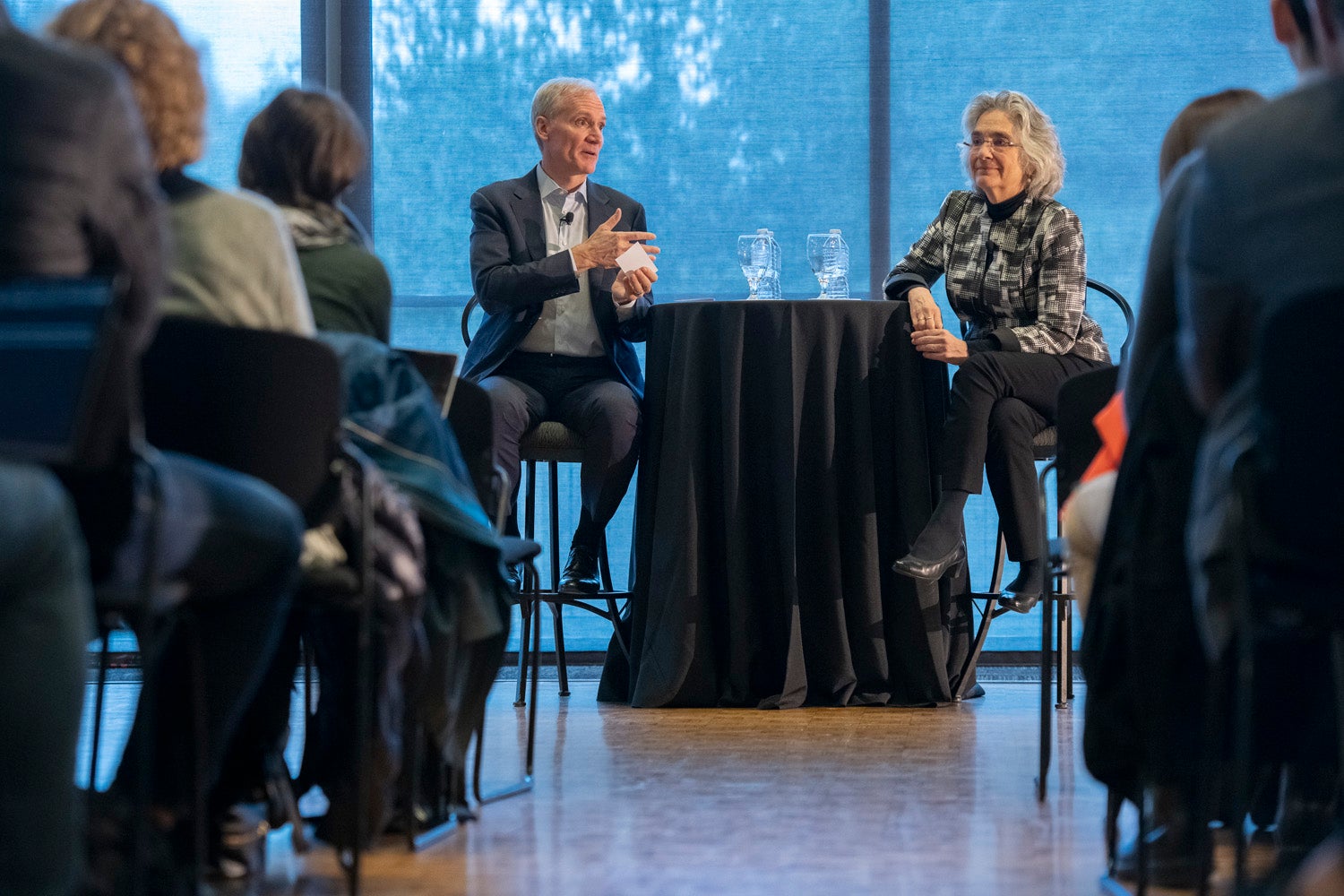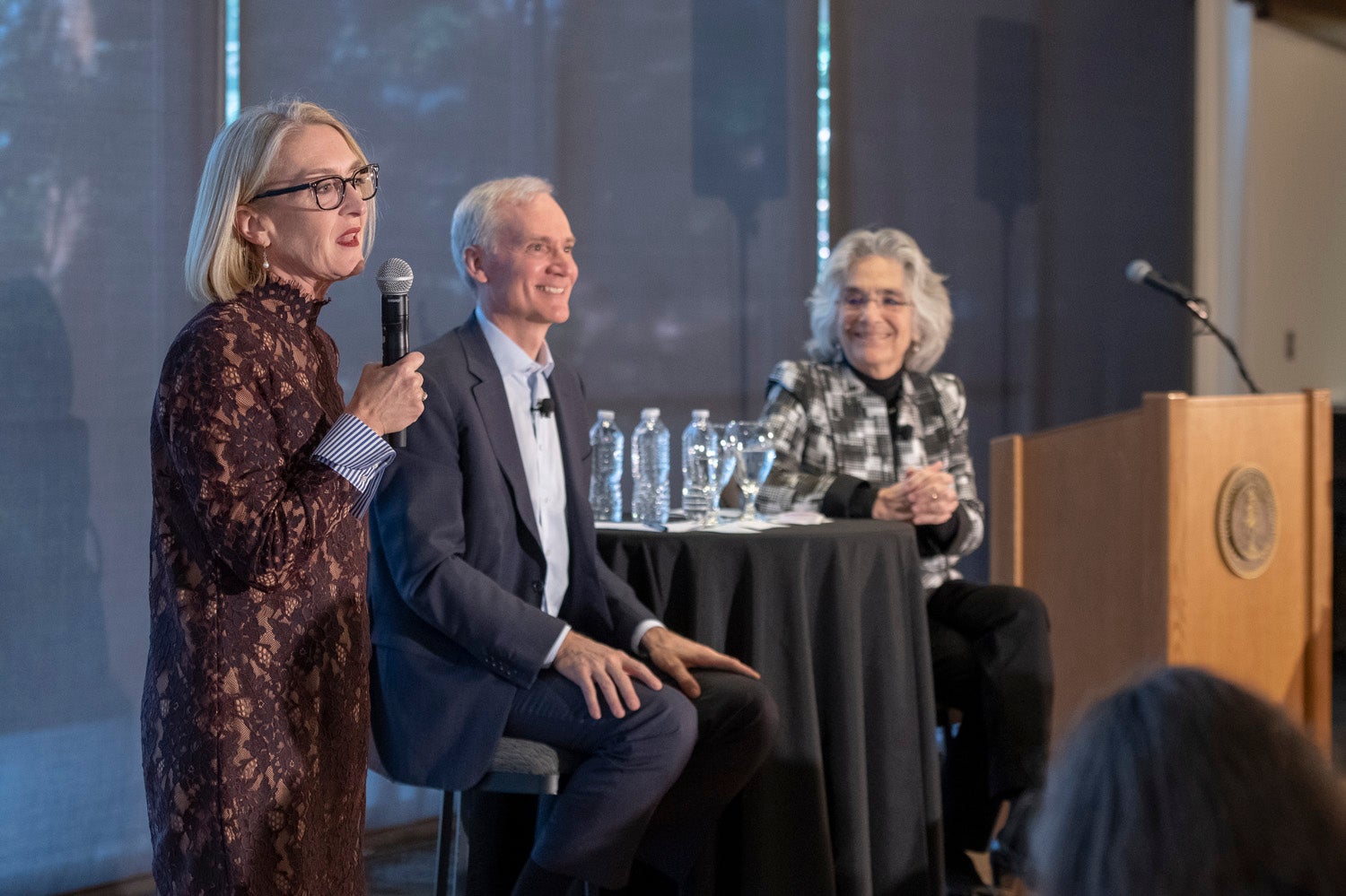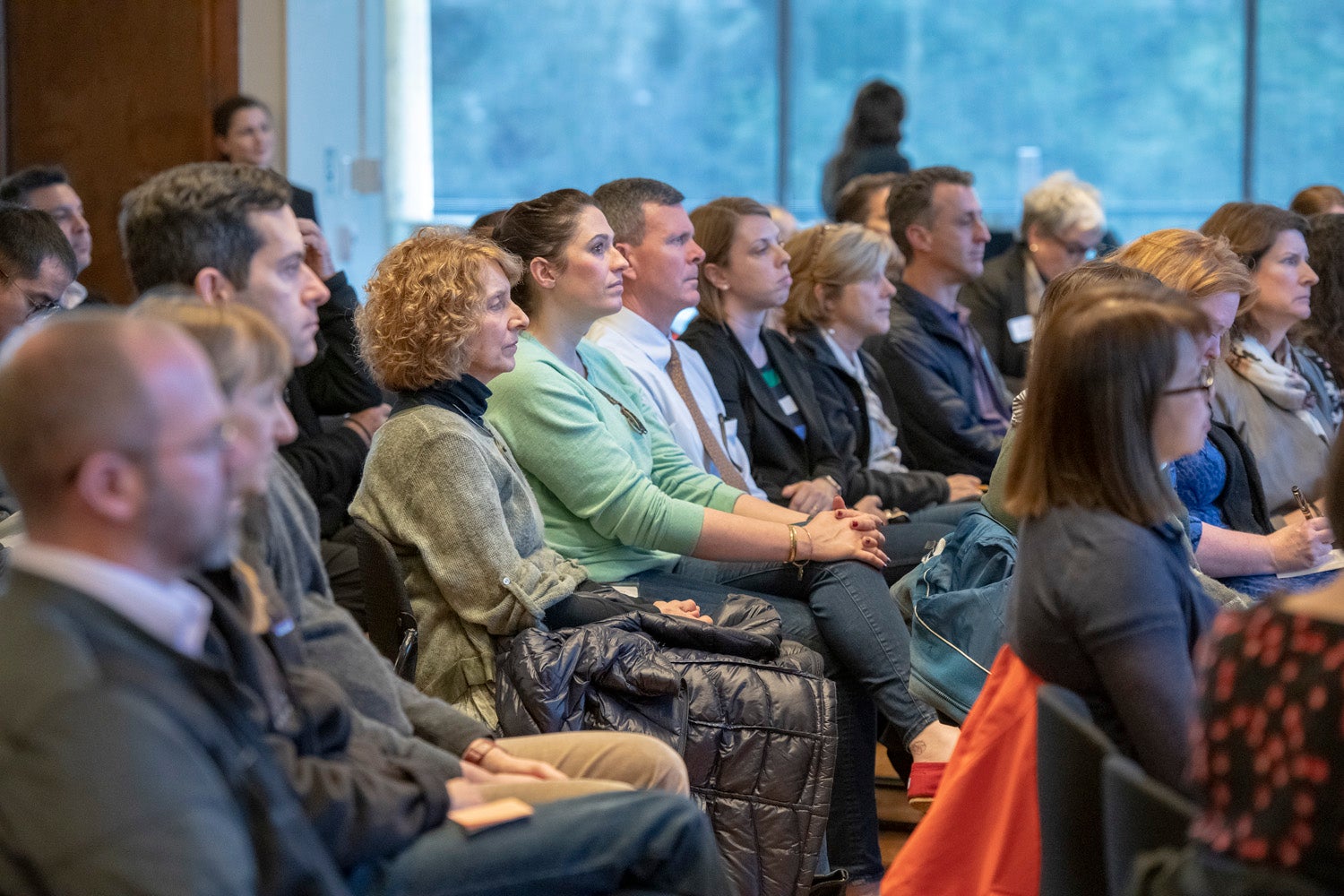President and provost hold conversation with the campus community
Among the topics discussed was what Provost Persis Drell called a “historic moment,” the opening of Stanford Redwood City with a ribbon-cutting on March 21.
President Marc Tessier-Lavigne and Provost Persis Drell updated the Stanford community on the long-range planning process and addressed a variety of topics, from the opening of the Redwood City campus to the results of the recent staff engagement survey, during a campus community meeting Friday morning.
The hour-long meeting in Tresidder Oak Lounge drew more than 100 staff, faculty and students. Drell began the meeting with the sad announcement of the death of a graduate student the previous night, and asked for a moment of silence.
In his opening remarks, Tessier-Lavigne gave an update on the university’s long-range vision. In May 2018, after a community-wide effort that generated 2,800 ideas, Stanford leadership outlined a set of priorities in education, research, community, and mission and values. Over the last 10 months, design teams have been working to turn those priorities into actionable plans.
Tessier-Lavigne said that the development and implementation of these plans is a staged process, with reports from the design teams being reviewed as they become ready. Plans will continue to roll out in the coming months and most will have been reviewed by the Board of Trustees by the summer, he said.

President Marc Tessier-Lavigne and Provost Persis Drell updated the Stanford community on the long-range planning process and addressed a variety of topics at a conversation with the Stanford community in Tresidder Memorial Union on March 8. (Image credit: L.A. Cicero)
He noted that some initiatives, such as Human-Centered Artificial Intelligence, will begin to take fuller shape very soon while others, such as the work of the Affordability Task Force, are “multi-faceted and complex” and will require more time.
He expressed gratitude to all those who have been working on the long-range planning process. “Taking the thousands of ideas we received and turning them into robust proposals is tremendous work – on top of everybody’s already busy jobs,” he said. “We’re really excited by many of the plans that are being put forward. The design teams have really done an amazing job of rethinking Stanford and our priorities in very bold ways.”
Tessier-Lavigne also introduced Matthew Tiews, who has been appointed to a new role as associate vice president for campus engagement. He said that Tiews will take the lead in an effort to reimagine the White Plaza area as a “vibrant community gathering space.”
Stanford Redwood City
In her formal remarks, Drell highlighted the imminent opening of Stanford Redwood City, which will be celebrated with a ribbon-cutting ceremony on March 21.
“It’s a really historic moment for Stanford – this is the first significant expansion for Stanford away from our original campus,” Drell said.
She emphasized that opening the new campus means change not just for those who are moving to the new campus but for everyone at Stanford. She encouraged the community to practice flexibility and adaptability and to use tools of technology to stay connected.
Beginning the week of March 18 and continuing through August, approximately 2,700 employees from nine units/schools will move to Redwood City. The first staff to move will be from departments in University Human Resources and Business Affairs. A schedule outlining which units are relocating and when they are moving can be found on the Cardinal at Work website.
Drell acknowledged the work of the leaders and staff of Land, Buildings & Real Estate, University Human Resources, University IT and operations in Redwood City.
“A very special thanks goes to those of you – some of you are in the audience – who are the trailblazing staff who are going to be based at Stanford Redwood City. You are critical to this university’s mission … and we can’t do it without you. I particularly appreciate the patience and flexibility of those of you who are moving to Redwood City as we all adapt to this major change,” she said.

Elizabeth Zacharias, vice president for human resources, joined the conversation with a presentation on the recent staff engagement survey. (Image credit: L.A. Cicero)
Drell concluded her remarks by mentioning the results of the recent staff engagement survey, praising the 67 percent response rate, an increase from 61 percent in the previous staff survey conducted in 2015.
“I was particularly happy to see that nine out of 10 staff surveyed expressed pride in working for Stanford and feel confident in the future of the university,” she said.
Following up on the provost’s comments, Vice President for Human Resources Elizabeth Zacharias said that her team is still “digging in” to the results, offering insights to leaders and teams across the university and looking for opportunities to take new actions. She said that some of the information gathered in the survey is directly connected to aspects of the long-range vision; for example, there were survey questions designed to better understand campus issues around diversity and inclusion.
Zacharias said next steps will include some follow-up sessions, such as focus groups, on specific issues. Operational efficiency was identified as an area of concern, and a group of university leaders is now meeting regularly to tackle the issue.
Questions from the community
Following their opening remarks, Drell and Tessier-Lavigne took turns answering questions submitted by the audience.
Tessier-Lavigne addressed questions about Stanford’s engagement with the external community. “Stanford is doing many wonderful things in terms of external engagement with our local community, our regional community, our national community and even our global community, but we didn’t have an overall framework for that engagement or a specific strategy,” he said.
He said that the university wants to take a more intentional approach to community relations by taking stock of all the activities and identifying top priorities. He also referenced the recent consolidated administrative structure of the offices of Public Affairs, University Communications, Development, and Special Events and Protocol under the leadership of Martin Shell, who was named vice president and chief external relations officer in June 2018. A new Office for Community Engagement will be added to this group.

The hour-long meeting with the president and provost drew more than 100 staff, faculty and students to Tresidder Oak Lounge. (Image credit: L.A. Cicero)
Drell responded to a question about Cardinal Conversations. She said that the discussion series is undergoing a major “reboot” and will most likely return next academic year with a new name. Some of the feedback on last year’s series centered on the lack of student engagement, and she said steps are being taken to assure that the program would be student-led in the future.
In response to a question about what steps Stanford is taking to avoid becoming overly focused on technology education, Drell said she was “extremely excited about the discussions and ideas” coming out of two design teams focused on undergraduate education: First YearExploration and Shared Intellectual Experience, and the Future of the Major.
“We do feel that students aren’t exploring richly enough in the first year in order to make the best informed choices for themselves,” she said. “The strength of Stanford is the breadth that we offer our students – that’s what prepares them best for a changing world that they’ll be going out into.”
The president added, “If you step back a little bit and think about the arc of the 21st century, this will be all about bringing insights from the sciences and engineering together with the humanistic disciplines – the social sciences, the humanities, the arts. Solving the great problems of the world requires bringing both together.”
Other topics the president and the provost discussed during the question-and-answer session included sustainability, alumni relations, family leave policies, measuring student learning outcomes and the university’s contract with academic publisher Elsevier.
